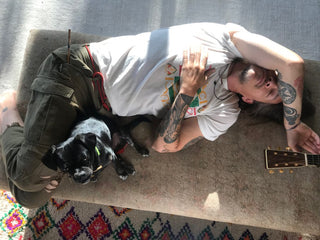Water is mighty beyond measure. Its immense force can push us away or pull us in. It can destroy us or it can bring new life. While water is one of the most bountiful substances in our bodies and on our planet, we still struggle to completely grasp the full breadth of its power. But some do an incredible job of harnessing water’s vast power and protecting our most vital resource.
As I prepared to write this story about Incubus singer and creative extraordinaire Brandon Boyd, it became readily apparent that water plays a massive role in his life. Growing up surfing in Southern California, it’s not hard to imagine how one could develop a profound respect and love for the water, and it shines through in everything Boyd creates. It’s always been a subtle recurring theme in his music, both with Incubus and side projects like his band, Sons of the Sea. It’s been a focus of Boyd’s charitable efforts as well, as his Water Is Life campaign a few years ago raised tens of thousands of dollars to support America’s indigenous tribes in their standoff against builders of the Dakota Access Pipeline.
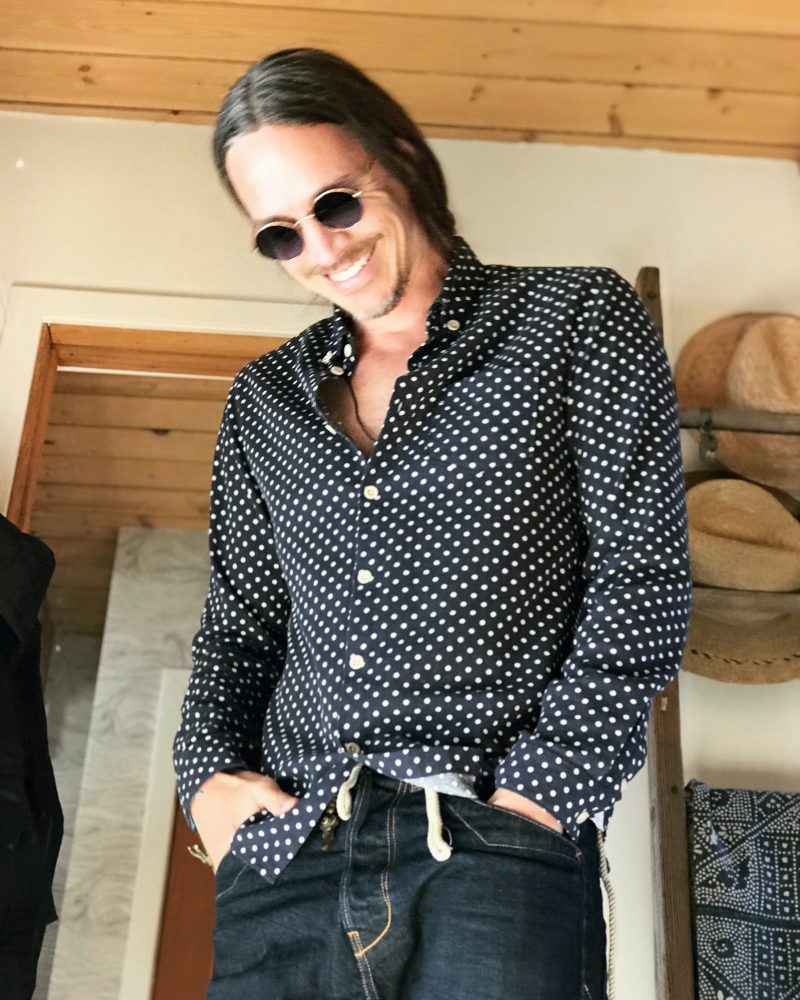
For many years, the decorated songwriter situated himself as close as possible to the Pacific Ocean, living near Venice Beach, but has returned to where he once came from, near the Santa Monica Mountains.
“I lived in Venice Beach for a long time but I moved back up here about three years ago. I grew up around here,” Boyd says from home, which sounds super serene, complete with massive art studio yurt. I had to Google yurts, too, be not ashamed. “Venice had a loving grip on me for a long time but I knew I would end up in this part of Los Angeles. It was kind of a long time coming.”
When I asked what prompted the move away from the ocean and back to where his roots were, I kind of already knew the answer. Humans ruin everything.
“Being able to walk or ride my bike to get waves every morning was definitely part of the allure,” he said of Venice. “That’s one of the things that I miss about living down there but the trade-off is pretty significant, just getting some breathing room and not having people on top of you literally all the time.”
“There was something about the changing of the guard,” Brandon tells me. “So many of my friends that had established Venice as part of their community started to leave and once Google and Snapchat moved in, it definitely changed the vibes down there pretty drastically. At first, it was slow. Then there was a moment I remember when it felt like it shifted overnight. I walked outside of my house and was like, ‘woah where did my neighborhood go?’ [laughs] I have no hard feelings or anything. I’m the first person to tell people that the only constant is change. We have to be willing to embrace changes like that and I’m lucky that I was able to find my window of opportunity. I found my place and came back full circle to where I started.”
But a little bit of distance has done nothing to weaken the bond Boyd shares with the water. If anything, it’s made him more creative in how he incorporates the precious resource into his life, and the results are really astounding. While art has always been a part of the singer’s life, his work has found itself in a flowing new current altogether recently. Boyd has been painting for years, showing in galleries across the globe and publishing a number of books of his art, but his watercolor works, in particular, have struck a nerve and mystified those who appreciate his abstract brushstrokes. Last month, Boyd released a limited edition set of playing cards that feature a series of his watercolors called Deux Portes / Two Doors: An OptiMystic Memory Game. Like memory games of old, players match sets of images, which in this case are Boyd’s watercolors labeled with a wide variety of synonyms for doors.
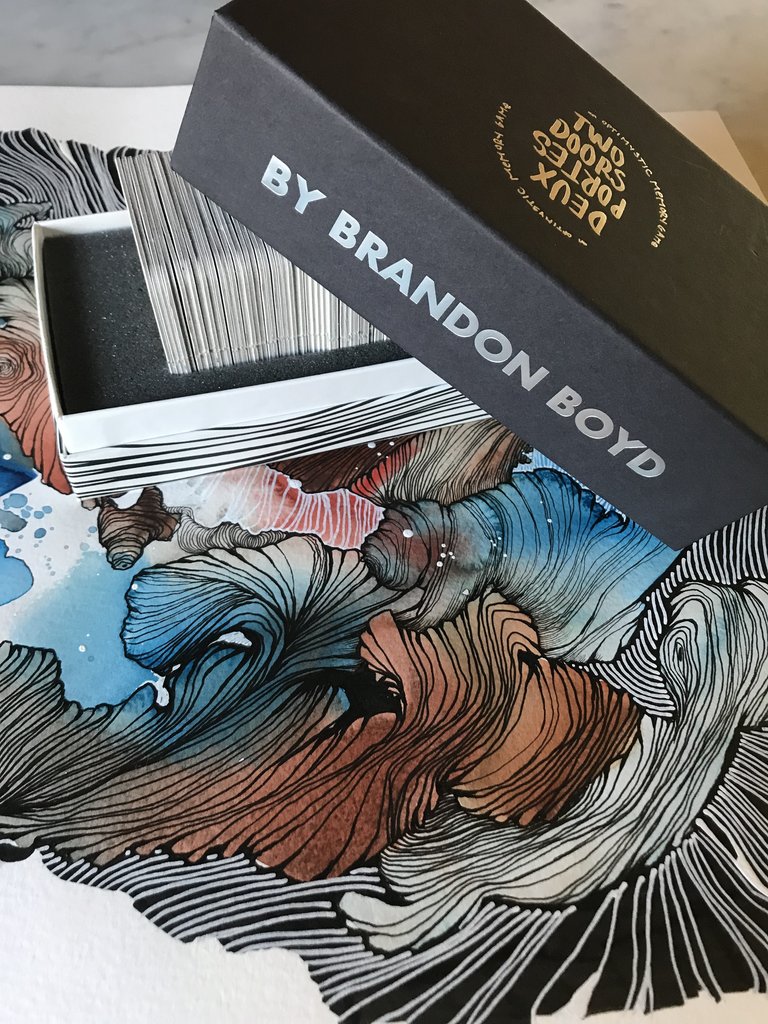
DUKE LONDON: Finding your window of opportunity to leave crowded Venice for the seclusion of the mountains brings me to my first question, about doors opening and closing. Your game is based on doors and portals, I’m wondering if you see these doors as an escape from something or the opportunity to experience something new?
BRANDON BOYD: It’s definitely not about escaping. If anything, it’s more about arriving. There’s something in the literal sense about doors that’s evocative to me but there’s also something in the deeper metaphor of doors that have always been intellectually tantalizing. I see them as opportunities, so I started doing these small paintings. I would do a few of them every day while we were on tour. When you’re on tour, it’s like long periods of waiting and anticipation interrupted by bursts of intense atmosphere and energy and then long periods of waiting once again. There are lots of ways to fill up that space in between concerts. Everyone has their own way of doing that, but I found years ago that painting was a really cool way to spend that time. It allows for meditation to take place in an otherwise chaotic atmosphere. I started doing these paintings and I saw them as little doorways or portals into another world. And every one of them was a little bit different but similar next to each other. There are maybe one hundred of them in total. I chose my favorite 36 or so of them and I was kind of making a game out of them that I used to play when I was a kid called memory where you match a chicken with a chicken and a frog with a frog. I was attempting to refine that idea and use these portals, so you find the two doors that match each other, theoretically opening up a larger portal into memory.
I read about another game you said your’s was somewhat inspired by, Brian Eno’s Oblique Strategies. I thought they were both interesting from a standpoint of using games as mental exercises. How do these games help you creatively?
I was first turned onto Oblique Strategies through a friend of mine who’s a musician, a producer named Dave Sardy. I’ve worked with him on music for Incubus and solo pursuits for quite a few years and he just had an original set of it in his studio on the soundboard. You know, we’re listening and turning knobs and my eyes drifted toward this black box. I opened it and there were these cards and I just started asking Dave, “what the hell is this?” [Laughs] He explained to me that it was a project by Brian Eno and Peter Schmidt, and you pull a card if you ever feel like you’re stuck creatively and don’t know where to go. The card that you pull is, in almost a divining kind of way, seemingly random but carries the possibility of steering you off into an unexpected direction. Occasionally, you’re doing to get stuck but if you introduce a chaotic variable there is the potential to wander into uncharted territory, which is really exciting. I don’t know if that’s what they had in mind when they created it but I found it really inspiring that they had done this. There’s an app that you can get now, but the idea of having a tactile card game seems so counterintuitive to where our culture has gone.
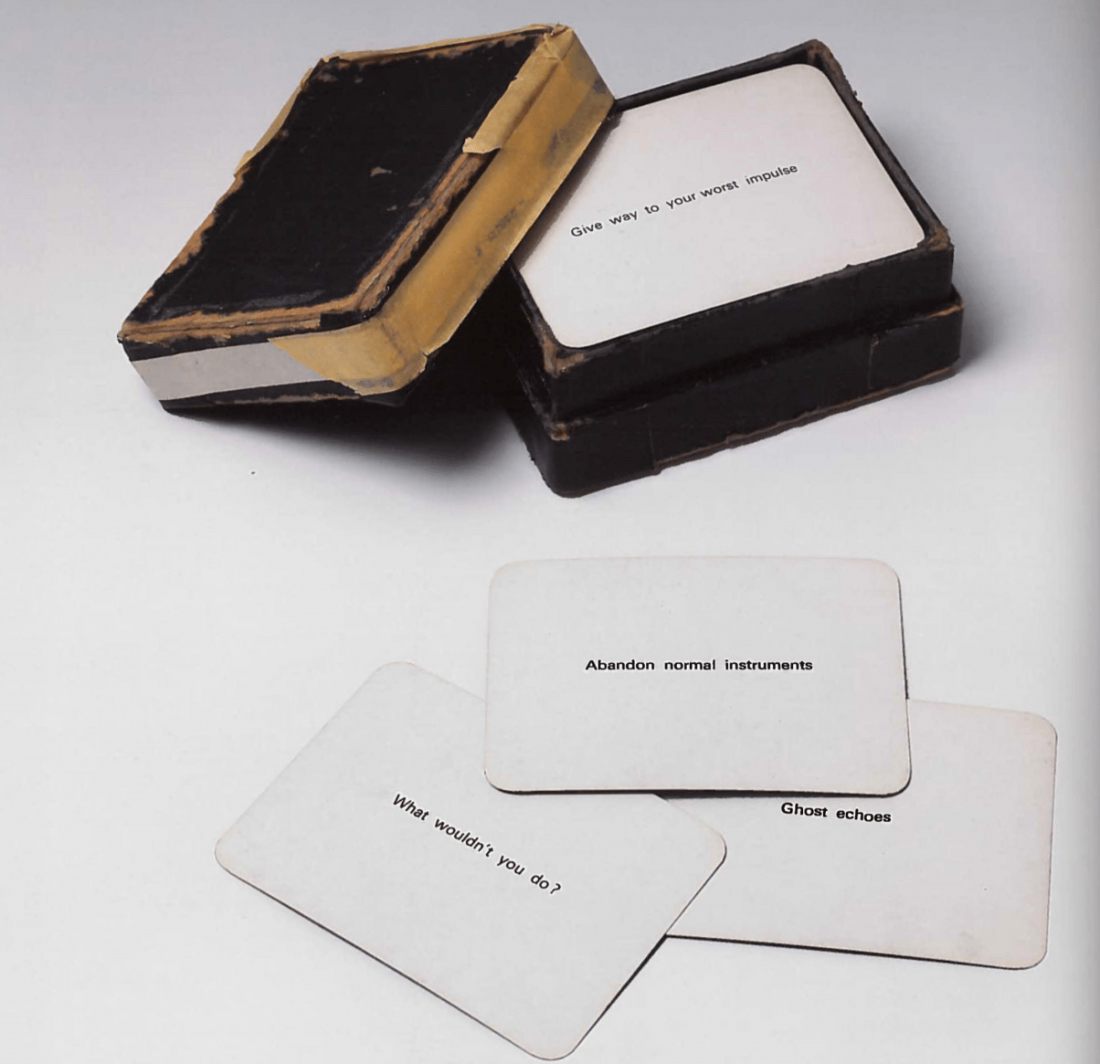
There’s a whole video gaming culture and technology and screens and tablets and swiping. You’d have to be living under a rock not to notice that. From the youngest kid to the oldest person, everyone’s faces are buried in their screens. We can talk about whether that’s good or bad or what that does to us in a whole different conversation but I just thought there was an opportunity to introduce a counterpoint to that with something that didn’t involve technology. It’s so old school that it’s almost modern again. Imagine that idea of spreading out cards with a couple of friends and trying to remember where each card is placed. And then they’re based on these sort of higher-minded ideals of breaking through perceptual doors.
It’s cool that it can bring people together and get people talking — probably not even about the game but about other peripheral things.
That’s exactly what it has been doing in my life. I’ve been playing with friends and loved ones and at first, they’re indulging me. “Hey play this game with me that I made” and they’re like “uh okay whatever” and then what happens is exactly what you just said. At first, they’re like, “Cool. You painted that? Cool.” And then it very quickly spins into a conversation that you would not have had otherwise had you not sat down with the person to play. It’s just funny because all humans need is to keep engaged with this peripheral activity that doesn’t have to do with something in a larger technological sense like cards. Something beautiful happens and that kind of simple cooperation is why we are so different from other animals. I feel like that’s something that people need to be reminded of or “remember” if I could be cheesy for a moment. [Laughs]
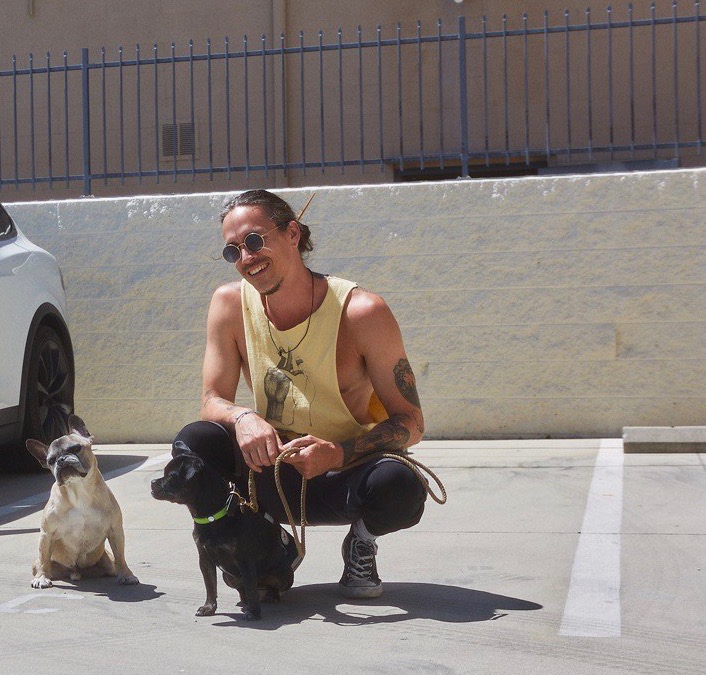
It’s not dissimilar from your songwriting in a lot of ways. Music today has become much more literal in its songwriting, very visceral storytelling. It seems to get straight to the point whereas your’s is and was more abstract in nature and allows for more interpretation. How is your art similar to your songwriting?
I’ve always been fascinated by words and their ability to be manipulated, arranged, and massaged in ways that can evoke emotion and memory, occasionally anger, occasionally fire. It’s a fascinating thing because when you break them down to their most rudimentary or literal sense, they are just a conglomeration of sounds that we all agreed collectively meant something. We’re just putting together sounds that we’re making out of our mouths and somehow we’re able to transmit things that are otherwise untransmittable. We can deduce incredible things about our history, each other, and our future through manipulating these different sounds. It creates a whole layer of complexity and potential abstraction that is able to do something else completely. You can tap into an emotion in somebody that they didn’t even realize was there, or a memory they had filed away somewhere, and it’s an amazing opportunity to communicate with each other on a higher level.
What it’s able to do is really transcend basic conversation. The conversation is very powerful in its own right but then music is this whole other thing. I’ve seen concerts in different places around the world where certain bands almost become like a religion to the audience. It’s really amazing. Incubus has opened for Metallica a handful of times in South America or places in Europe and it is insane. When Metallica goes on stage in South America, it’s like you’re watching a religious rite happening. It’s fucking crazy. Because some people are like, “yeah Metallica is rad, we drink beer and thrash” but other people are like, “yeah we do that but it also connects in a way that you had no idea was even possible.” It’s just an incredible and it really inspires me, excites me. I think that’s probably why I still make music. It’s continually confounding to me and it’s fun but the potential of it reveals itself to be more and more limitless the longer I do it. I always say it’s as challenging as it ever was but then I think I see a bigger picture the older that I get.
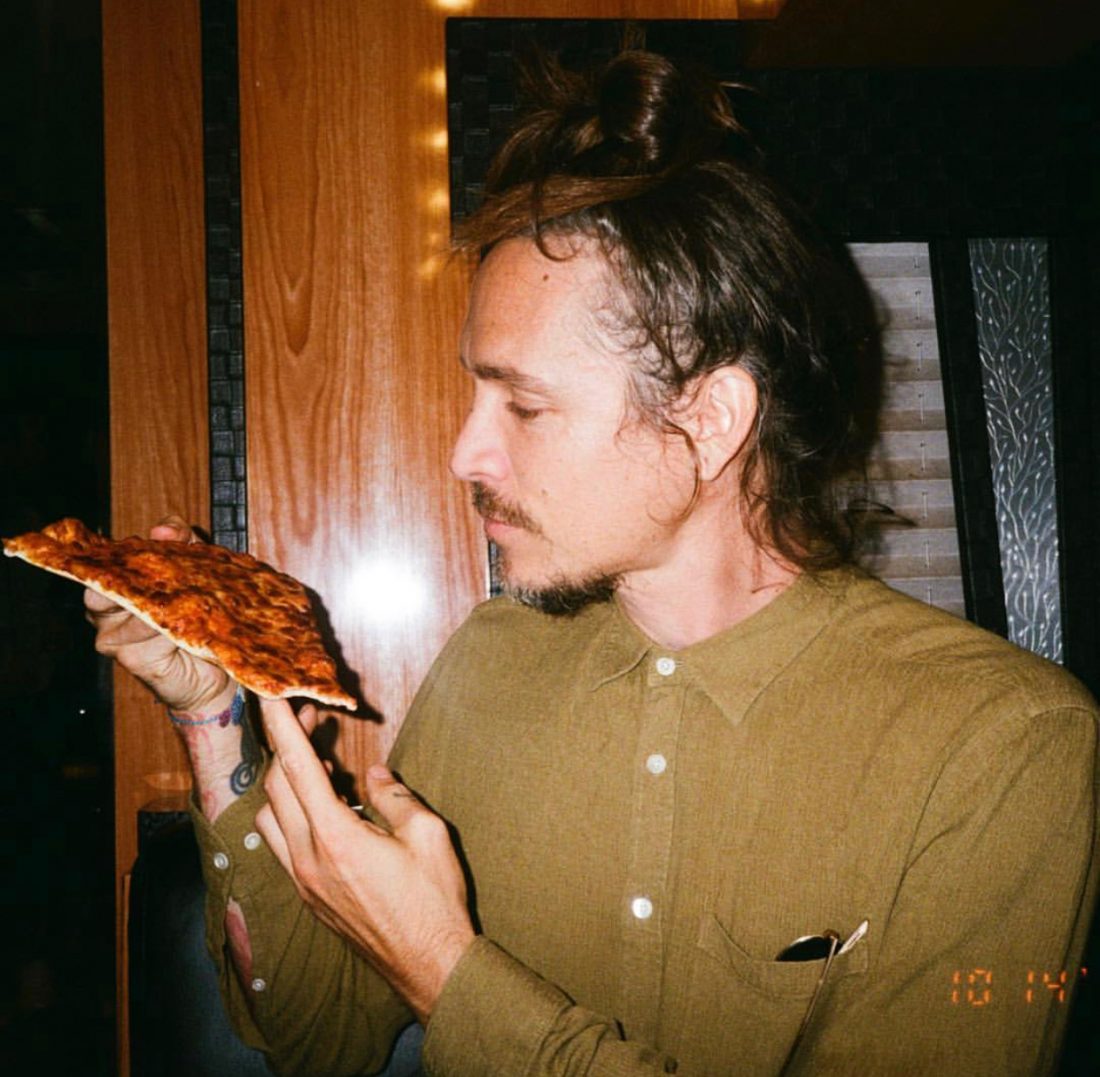
For someone that has seen so much of the world, what doors are you still trying to go through, where do you still want to go?
There are two answers to that question.
I’m always looking for new doorways and a higher plane, I suppose. There are lots of ways to get there, from very old spiritual disciplines, meditation of trance, etc. but we also have certain tools available to us here that nature provides. Those are potential doorways into a world that exists simultaneous to ours but we just don’t see on a daily basis. That’s definitely a little bit more dangerous, depending on who you are and where you are and what you’re ingesting, so I always encourage a great deal of reverence for some of those tools and maybe even caution for some people.
On a more Earthly level, I’ve never been to Vermont.
I was not expecting Vermont. [Laughs]
We’ve played all over the world. I mean, we’ve played places I thought we would never ever visit. Still never played in Vermont. I don’t even know why, so one day I’m just going to go up there and go maple syrup hunting.
I’ve been in LA for about four years, but I actually lived in Vermont for a little bit at one point. I can vouch for it, it’s worth a visit.
No way! I definitely will go one of these days.
We’re approaching the 20th anniversary of Make Yourself, which seems pretty crazy. Looking back, what does that album mean to you now?
It’s really wild that it’s 20-years-old. It’s almost old enough to drink, it’s incredible. We’ve been rehearsing for some upcoming shows recently and we’ve been dusting off songs from that record that we haven’t touched in quite a few years. It’s definitely been pulling up some old memories from when we wrote them in the late-90s and early-2000s.
Just speaking really quickly to the power of old music to dredge up old memories and bring you back to exactly where you were when you first heard it — or in our case, performed it. I think I was 22, turning 23 when we wrote that record, and it’s such an interesting time in any person’s life because it’s fun, it’s exciting, but it’s also really chaotic and weird. There are a lot of growing pains taking place, so a lot of the songs on that album are dealing with stuff like that for me. We were just going on tour for the first time for real, like being on tour internationally a lot. We’d been touring for a couple of years behind S.C.I.E.N.C.E. but it got really intense around Make Yourself. There are some of those old anxieties that still linger in those songs and when we’re playing them in the rehearsal studio, it’s crazy that I can feel those long-forgotten anxieties by playing a song once.
It’s interesting to go back to that stuff but for the most part, it’s really just an incredible joy to be able to say we have a record that’s 20-years-old and people still like it. And we still enjoy playing these songs. We have other older songs that we’ll start playing and after 40 seconds, we’re just like, “eh, no.” [Laughs] But Make Yourself holds its own, so it’s fun.
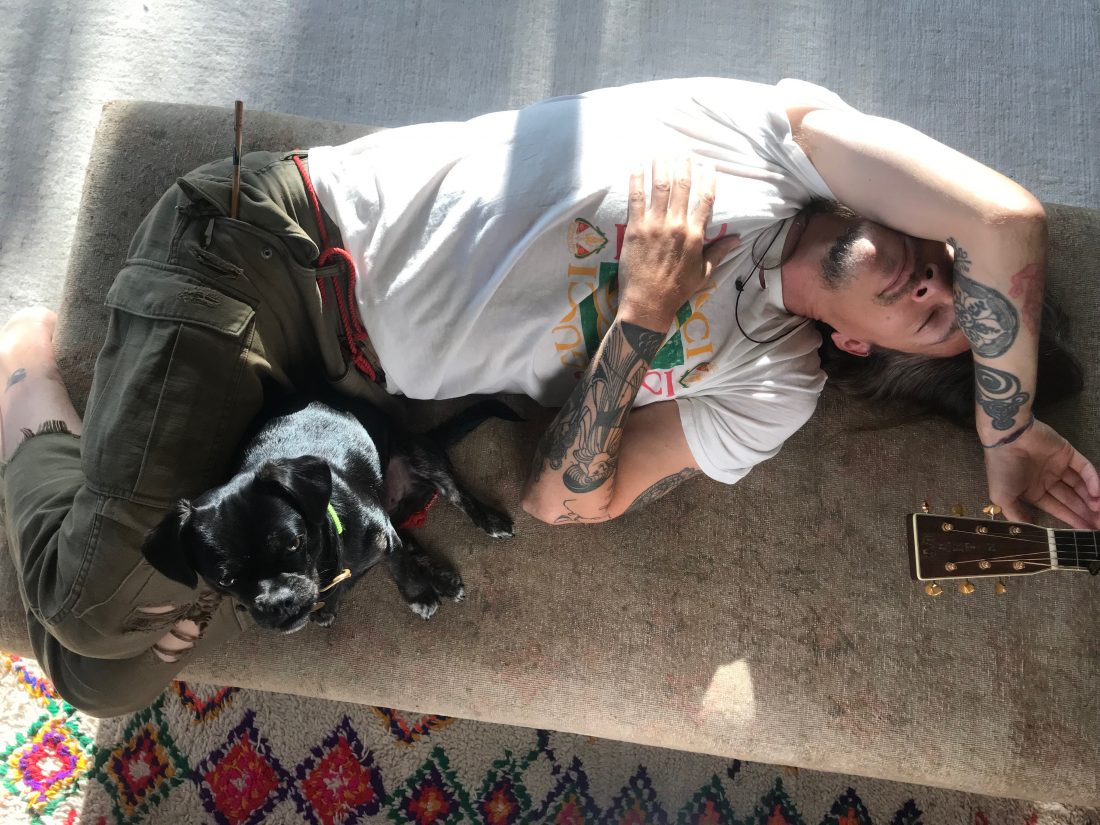
Do you think it’s aged well musically and from a thematic standpoint? Do any of the songs take on a different meaning for you now? “The Warmth,” “Out From Under,” and the title track all hit a little different in the midst of late-stage capitalism and some of the things we’ve seen happen in the years since they came out.
For sure, though I don’t know that I’d offer that up on my own. It would be a little too self-indulgent as a songwriter to say those kinds of things but I appreciate when people are able to appreciate what is technically older music — as hard as it is for me to say that [laughs] — in a more contemporary sense. I think what it reveals to me is that certain cultural and political phenomenon do have a cyclical quality to them and some of the ideas that were pouring out of us at that time — and even later with songs like “Megalomaniac” — they were written during a time that felt, at least politically, like things couldn’t get any worse. And then, oh my God, we’ve seen the bottom of the barrel now. Things seemed to get better culturally for the better part of ten years. Nothing was perfect, obviously, but there was at least a sense of hope. So, some of those ideas seem to be resurrecting again. I think that’s really one of the points of music though, if there is a point to music, that it has this capacity to remind us of some of the things that we thought were important at one time.
Our “Sick Sad Little World.”
Yeah. It’s interesting, sometimes the way that songs are written, especially from a lyrical standpoint, I don’t even know what I’m writing about most of the time until after the fact. So, it’s funny. As you can probably relate with as a writer, you sometimes get into a flow state where stuff just starts pouring out of you and you don’t even question where it’s coming from. And then you look back on it, days or even years later, and you’re like, “oh wow, I get it now.” You’ll understand the subtext of what you were talking about later and it makes more sense in retrospect.
For some musicians, the artwork is just artwork. But for Incubus, it always felt like art direction was a huge part of the process, a running theme throughout the music, the videos, and the physical product. What role did you play in the artwork for Incubus albums over the years, and what spawned your own personal artwork?
I’ve been painting and drawing ever since I was a little kid, since before I can even remember, honestly. My first memories are scribbling with crayons. Art offers something truly hard to describe for me. There are lots of artists in the world and any one of them in any discipline will probably tell you the reason they keep making art is that they like it — they don’t really know why. I kind of just have to. That’s something that has always permeated my experience. I started getting in touch with music as a teenager and started going to concerts in Los Angeles in the late-80s and early-90s and saw a lot of amazing bands. It was incredibly inspiring and a very dense period of time for music, especially rock. I knew I wanted to be in a band at that point and it felt like art but a different medium. It felt like I was using a different kind of paintbrush. The two mediums have existed simultaneously for almost my entire experience.
I’ve known our drummer José Pasillas my whole life and he’s an artist as well, we’ve always bonded over art and surfing and skating. As far as album artwork and visuals of our band, he and I have largely been crafting the aesthetic of our band from the beginning, whether it be album covers or T-shirts. This band is very involved in every ounce of output that our listeners have seen over the years, for better or worse. We’ve definitely had a few misses, maybe even more misses than hits in that department [laughs] but we’ve made a couple of really cool music videos along the way as well as a couple of really cool album covers.
Some of my favorite albums covers that we’ve used are ones that we didn’t design ourselves but commissioned from other artists. Our record Light Grenades was done by an artist named Alan Aldrich, who became famous for his album covers and liner artwork for The Beatles and Elton John and all of these other amazing legacy artists. We became friends with him and I asked him to design our album cover and he said, “Absolutely, I’d love to. What’s the album like?” I had to tell him that we hadn’t finished recording it yet, but I gave him all of the lyrics to the record and hoped he could construct something based solely off of the lyrics. This guy didn’t hear any of the 13 songs and he made what has become some of the most recognizable Incubus artwork. A lot of people are under the impression that I did it but I just pointed a really amazing artist in a direction and he went to town. It’s so cool. You can actually see the artwork and all of his sketches leading up to the final art in a book he published right before he died, called The Man With Kaleidoscope Eyes. Pretty amazing.
I remember you also had a fan contest to create the official music video for the single “Dig.” It’s interesting, considering how involved you guys were in the artistic direction of the band, that you left so much of it up to outside artists for the Light Grenades album.
Hmm, I love the idea of just that. I’m an artist in my own right, but I also love the idea of encouraging people to participate if they’re interested. We got so many submissions for that “Dig” contest, it was almost an impossible undertaking to select a “winner.” We eventually found a handful of gems and we would argue and commiserate over which one was the best and there were some complications with our record label at the time, so there was a US winner, an overseas winner, etc. The one that struck me the most, though, was the one where the artist took Alan Aldridge’s drawings and animated them. I hope that’s the one people see and associate with our song.
What draws you to watercolor in your own art?
It’s sort of my favorite medium for the past seven or eight years. I work in other mediums as well but watercolor is one of the more challenging, which is probably why I gravitate toward it. I feel an overwhelming urge to master it but I don’t know if that’s possible. I’ve seen the work of people that I would consider masters of watercolor and even those people will tell you that they have not mastered it. It’s so chaotic and hard to control that people either give up or they are forever determined to make sense of it. I do a lot of figurative work in watercolor and mix it with abstract line work and things like that, but the Portal series of paintings were the beginning of my attempt to make sense of the chaos of watercolor. I would just spill it and throw colors in at random and let them dry, trying to find images at various stages of drying. It’s kind of like when you lay on a hill and see pictures in the clouds.
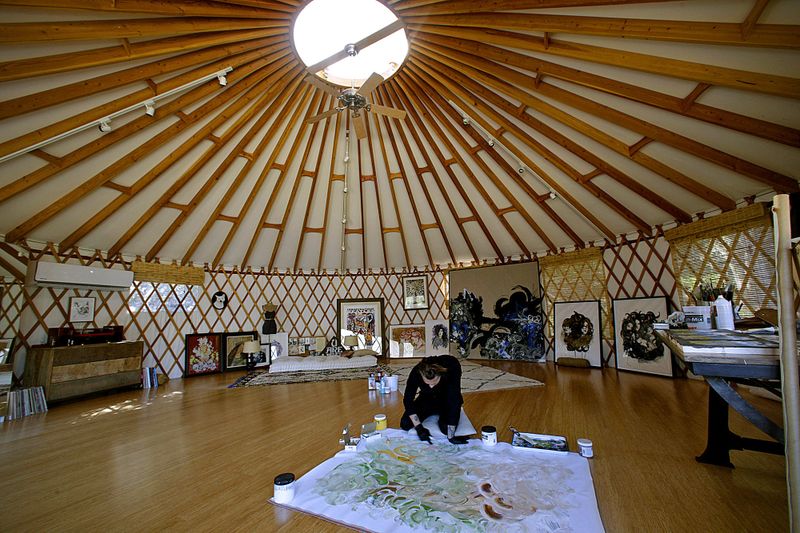
I read that the yurt on your property that you use as an art studio is the largest area in which you’ve been able to paint. With you on the floor painting on large canvases, how do your dogs play into the art direction of your work?
They are ever-present. They’re my shadows, I call them my little demon shadows all the time. [Laughs] There was a period of time where I was trying to keep them away from the paintings because of the potential mess. My older dog Bruce has always been wary of paintings for the most part. I don’t know why but he keeps his distance from them. Once in a while, he’ll drag himself over onto one of my paintings because he only has the use of two of his legs at this stage of his life. My younger dog Billy, she’s about a year old, a chihuahua-pug mutt of some kind, and she doesn’t give a shit. She’ll just cruise over and walk on wet paint and then walk all around, so a handful of my paintings I’ve done in the past six months have puppy paw prints trailing off of them. At first, I was like, “Nooo,” but then I realized that it’s actually pretty cool. The real artist has spoken.
How much mellower is a press tour for a memory game and paintings than an Incubus tour?
[Laughs] It’s a lot more mellow just because art feels like a more insulated world, even though it’s a huge world and there are no limits on who can participate. I guess not as many people are as interested in talking about painting as they are about music. I’d be so happy if painting became the new rock and roll, but I doubt it’s going to happen. Art is so much more open to interpretation, and music is highly open to interpretation. It’s a world filled with comically intellectual people who stand in front of paintings and “interpret” them and I love it. There are certain occasions where I’m thinking, “OK, yeah, I can see how this is all of those gigantic words you just smashed together,” but more often I’m just like, “That’s a gorgeous shade of pink the artist used” and move on.
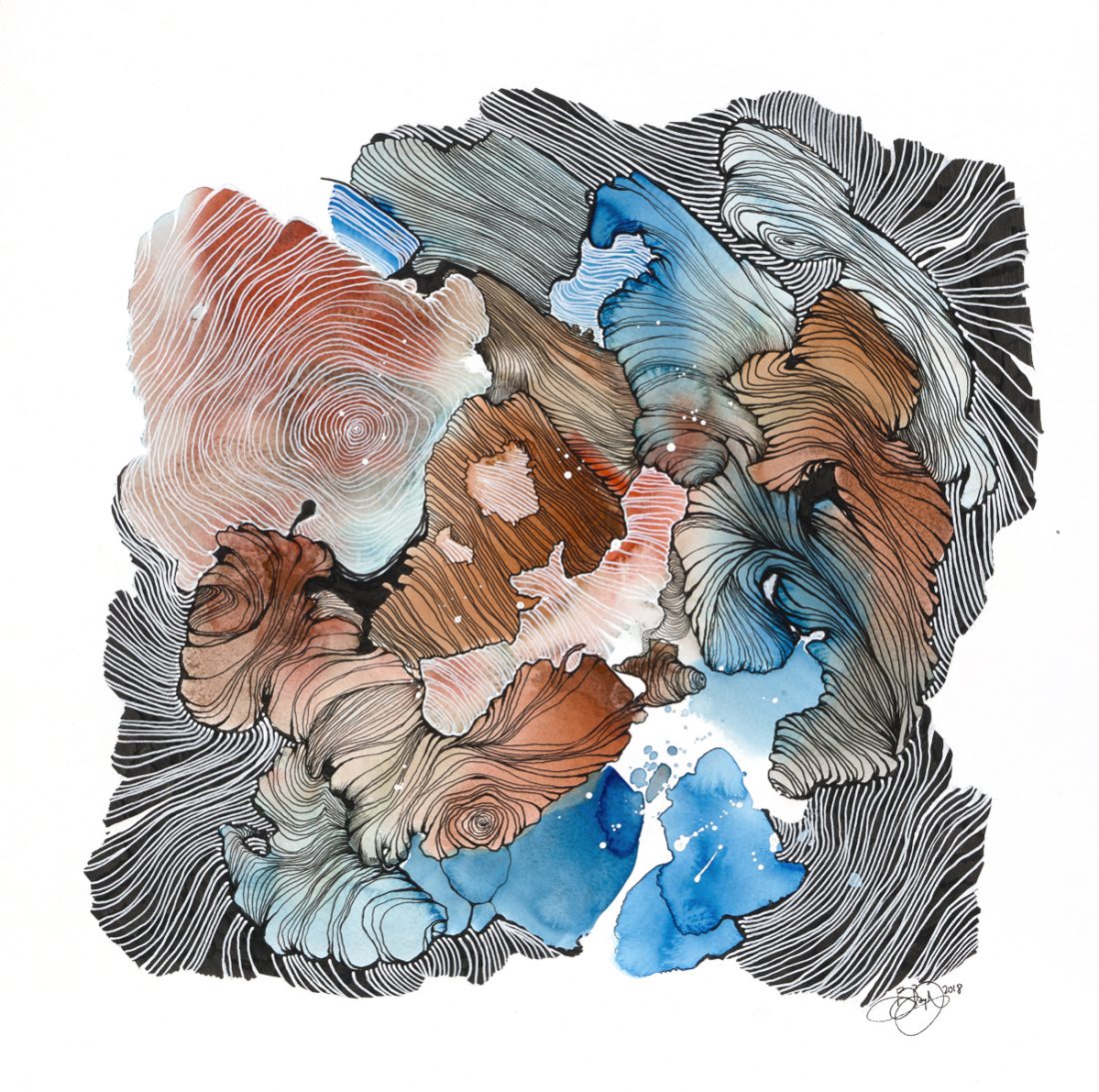
Though this story won’t come out until a later date, we’re speaking on Earth Day, so it’s only right we discuss Mother Nature. You’ve been outspoken over the years about ocean conservation and the problem with plastic. How much worse has it gotten and what are some positive steps you see being taken today?
It has definitely gotten worse. And I suppose we always knew that was going to happen. Before there’s a political will to do anything about major environmental issues, nothing is really going to happen on a mass scale. But what’s interesting is that the grassroots movements have graduated beyond the grassroots. At a certain point, we’re not going to need the political will to institute change, enough people will start taking responsibility for their own carbon footprint and it will just become the law of the land by itself, rather than being mandated by political power. Though that would help, I don’t think we’re going to get that help anytime soon. Once people have good, reliable information, they’re more apt to make lasting changes in their lives. You get good information in people’s hands and good things happen.
I like to encourage people to wean themselves off the addiction of single-use plastic. I like to encourage people to be aware of their general carbon footprint as much as possible. I have to constantly remind myself because we live in a culture that is desperately trying to get us to move faster and forget the impact we make. With eight billion people or however many of us there are on the planet, that’s just completely unsustainable. Anything and everything that we can do to remind each other that we leave a mark is important. We’re a unique animal in that we constantly reshaping the landscapes that we find ourselves in, and not only with our physical footprint and the things we leave behind but also on a cellular level. We’re affecting the world in a way that nobody ever really imagined. It’s good to keep those things in perspective.
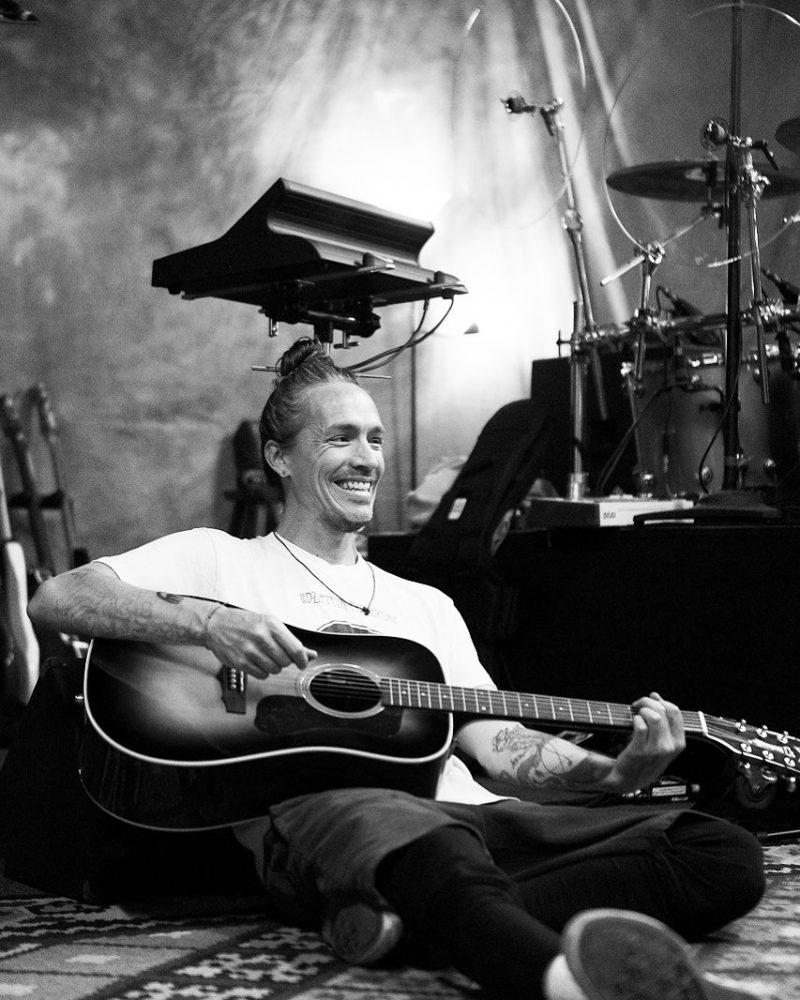
As you get ready for tour again, how do you ensure your band’s footprint is sustainable?
It’s such an important question and it’s something that we’re very much attempting to improve all the time. We’ve experimented with recycling programs on event sites and utilizing alternative fuels for the trucks and buses we use for travel. The bottom line is that touring itself is kind of an unsustainable activity. So, we try to do everything we can to lessen our carbon footprint through our charity, the Make Yourself Foundation. We have done very large carbon buybacks where we make donations that plant trees in certain deforested parts of the world so we can offset our touring. Even down to offering our fans reusable water bottles. Every little thing is helpful. One of these days, we’ll figure out a way to tour with zero carbon footprint but we’re not quite there yet.
Are you guys prepping any new music for the upcoming tour?
Yes, we’ve actually been writing for the past few months and we’ll be releasing a new single very soon. We’re pretty stoked about it and it’s super weird and fun. We’ll be on tour throughout the US in the fall.

